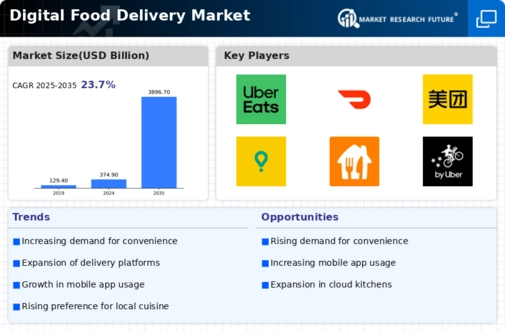Market Growth Projections
The Global Digital Food Delivery Market Industry is poised for remarkable growth, with projections indicating a market value of 3896.7 USD Billion by 2035. This anticipated expansion reflects a compound annual growth rate of 23.72% from 2025 to 2035, highlighting the increasing reliance on digital platforms for food delivery. The growth trajectory suggests that consumer behavior is shifting towards online ordering, driven by convenience and accessibility. As the industry evolves, it is likely to adapt to changing consumer preferences, further solidifying its position in the global market.
Increased Smartphone Penetration
The proliferation of smartphones significantly influences the Global Digital Food Delivery Market Industry. With an increasing number of consumers utilizing smartphones for various daily tasks, the accessibility of food delivery applications has improved markedly. This trend is particularly pronounced in urban areas, where smartphone penetration rates are high. As more individuals turn to their devices for meal solutions, the market is poised for continued expansion. The convenience offered by mobile applications aligns with consumer preferences, suggesting that the industry will thrive as smartphone usage continues to rise globally.
Expansion of Restaurant Partnerships
The Global Digital Food Delivery Market Industry benefits from the ongoing expansion of partnerships between delivery platforms and restaurants. As more eateries recognize the potential of online ordering, they increasingly collaborate with delivery services to reach a broader customer base. This trend is exemplified by the growing number of restaurants available on various platforms, which enhances consumer choice and convenience. With the market expected to reach 3896.7 USD Billion by 2035, the proliferation of restaurant partnerships is likely to be a key driver of sustained growth, as it enables consumers to access a diverse range of culinary options.
Rising Consumer Demand for Convenience
The Global Digital Food Delivery Market Industry experiences a notable surge in consumer demand for convenience. As lifestyles become increasingly fast-paced, individuals seek quick and efficient meal solutions. This trend is reflected in the projected market value of 374.9 USD Billion in 2024, indicating a robust appetite for digital food delivery services. Consumers are drawn to the ease of ordering meals through mobile applications and websites, which streamline the dining experience. This shift towards convenience is likely to continue driving growth in the industry, as more consumers prioritize time-saving solutions in their daily routines.
Technological Advancements in Delivery Platforms
Technological innovations play a pivotal role in shaping the Global Digital Food Delivery Market Industry. The integration of artificial intelligence and machine learning into delivery platforms enhances user experience by providing personalized recommendations and optimizing delivery routes. These advancements not only improve efficiency but also increase customer satisfaction. As technology continues to evolve, it is expected that the market will expand significantly, with a projected compound annual growth rate of 23.72% from 2025 to 2035. This growth underscores the importance of technology in meeting the evolving demands of consumers in the digital food delivery landscape.
Changing Consumer Preferences Towards Online Ordering
Shifts in consumer preferences towards online ordering are reshaping the Global Digital Food Delivery Market Industry. As consumers become more accustomed to digital interactions, the appeal of ordering food online grows. This change is driven by factors such as the desire for variety, ease of access, and the ability to compare options. The increasing reliance on digital platforms for food ordering is likely to sustain market growth, as evidenced by the projected market value of 374.9 USD Billion in 2024. This trend indicates a fundamental shift in how consumers approach dining, favoring the convenience of online solutions.


 Source: Primary Research, Secondary Research, MRFR Database and Analyst Review
Source: Primary Research, Secondary Research, MRFR Database and Analyst Review












